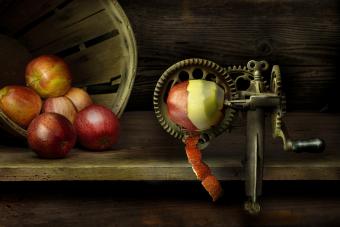
From blowing pinwheels to adding spinner rims to twirl inside a tire, we're obsessed with watching images be created out of speed. One colorful way to scratch that itch is by looking through a kaleidoscope. These groovy toys with a childish reputation weren't born out of whimsy but rather real science experiments at work. Learn all about these cool tools and see just how valuable vintage and antique kaleidoscopes are today.
Antique Kaleidoscopes: Where Science Meets Art & Play
Despite being the kitschy toys we all begged for at the county fair, kaleidoscopes have a long history steeped in scientific discovery. You have physicist Sir David Brewster's science experiments on the polarization of light as it passed through glass plates to thank for the trippy colorful patterns that're replicated a thousand times over today.
In 1817, Brewster patented his kaleidoscopic device, and it became a massive hit within the decade. Victorians were fascinated by the bright colors and unpredictable imagery. And in a period of time where innovation, invention, and creativity were highlighted, it's unsurprising that something that married art and science would be a massive success.

By the mid-19th century, kaleidoscopes had traveled across the pond. It wasn't until the early 20th century that these luxury metal kaleidoscopes were transformed into something cheaper and more accessible. Thus, the toy kaleidoscope craze began.
Types of Antique and Vintage Kaleidoscopes
The novelty kaleidoscopes you picked up at the zoo as a kid aren't the be all and end all of kaleidoscopic designs. Incredibly, there's a wide world of kaleidoscopes you can explore.
Wheel Kaleidoscopes
Wheel kaleidoscopes have two distinct parts - the wheel and the tube that you look through. A lens is situated at the top of the tube, with multiple layers of multi-colored glass connected to a central axis on the other end (making up the wheel). These circular panes spin at a fast speed creating an ever-changing pattern you can view through the scope.
Parlor Kaleidoscopes
Parlor kaleidoscopes are the most elevated antique kaleidoscopes on the market. They're made out of higher quality, sturdy materials like brass. These kaleidoscopes come with tripod-like settings for them to sit on tabletops or mantles in the parlor, a common social place in Victorian homes. As a sedentary piece, this kaleidoscope was much more than just a kid's toy. Instead, it was a statement of technological progress as well as wealth.
In a way, these kaleidoscopes were the huge flat screen televisions of their time. You could impress your guests with your new gadgets and let them feel envious of your life and station.
Dry Cell Kaleidoscopes
Dry cell kaleidoscopes are cheaply made kaleidoscopes that don't have liquid or refracting glass to create their patterns. Instead, they have tiny colorful pieces of glitter, sequins, etc. that you can manipulate yourself by rotating the end piece.
A quick way to spot a dry cell kaleidoscope is by their flashlight-like shape.
Oil Cell Kaleidoscopes
Much like parlor kaleidoscopes, oil cell kaleidoscopes are higher quality and more expensive than many other versions. These kaleidoscopes are built with hollow glass panes that are filled with colored mineral oils. This fluidity creates the most non-repetitive patterns out of all the styles.
Antique and Vintage Kaleidoscope Makers to Look For
It might surprise you that there are a few household names in the kaleidoscope market. These 19th and 20th century makers made valuable kaleidoscopes which are still sought after today. So, check any old kaleidoscope you come across for these notable names.

- Chesnik-Koch
- C. G. Bush & Co.
- Gilbert & Sons
- Van Cort Instruments
- Corki Weeks
How Valuable Are Antique and Vintage Kaleidoscopes?
Antique instruments are difficult to find in good condition; they just weren't passed down in the same way jewelry, clothing, or linens were. While condition, style, and buyer interest all have a part to play in determining how valuable an antique kaleidoscope is, 19th century 'scopes are relatively rare and worth upwards of $500-$1,000. For example, this parlor kaleidoscope from 1873 sold for $301 on eBay.
Meanwhile, vintage kaleidoscopes from the early and mid-20th century aren't always worth that much. Toy kaleidoscopes can sell for about $10-$30 at most, like this 50s snowflake Steven kaleidoscope that only sold for $24 online. The most expensive ones were handcrafted by notable craftspeople and will sell for a few hundred dollars.
It's important to keep in mind that, based on rarity and age alone, these pieces should probably be worth more money. But in a niche collector's market, demand is the most significant factor. People have to pony up the money to raise prices, and it's hard to do in the kaleidoscope world.
What Are Kaleidoscopes' Lasting Legacy?
Today you can see how kaleidoscopes have impacted culture far beyond the toy world. These swirling, colorful designs influenced generations of textile artists. Quilters, tie-dyers, embroiderers, and jewelers around the world continue to create pieces influenced by these unpredictable moving scenes.
And it's a passion people connect over as well. The Brewster Kaleidoscope Society is one place that kaleidoscope makers and fans come together to learn more about the craft and share their creations.
Let the Past Hypnotize You
If there's one thing ASMR videos and audio have confirmed, it's that people love to be soothed by rhythmic patterns. What started as an accidental discovery has turned into the delight of kids everywhere. And, it can be your delight, too, if you happen to find one of these rare and valuable antique kaleidoscopes from long before your time.







